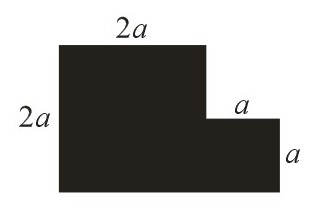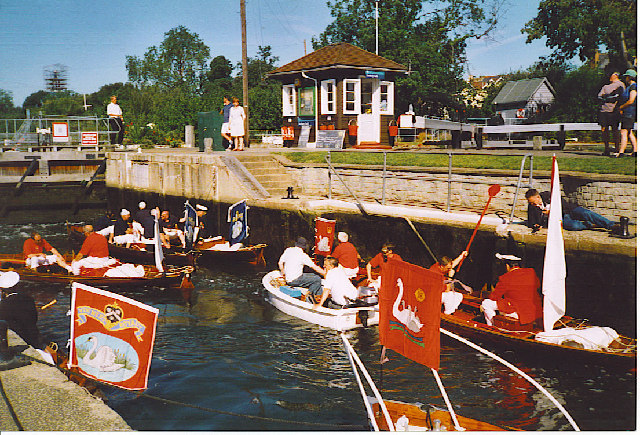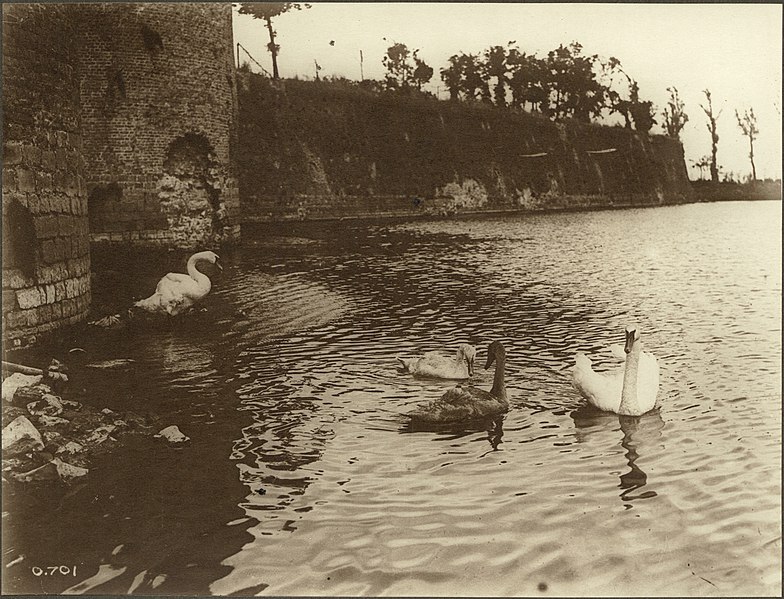“Garçon!” the diner was chargin’,
“My butter has been writ large in!”
“But I had to write there,”
Exclaimed waiter Pierre,
“I didn’t have room in the margarine.”
(Thanks, Larry.)
“Garçon!” the diner was chargin’,
“My butter has been writ large in!”
“But I had to write there,”
Exclaimed waiter Pierre,
“I didn’t have room in the margarine.”
(Thanks, Larry.)

A pretty dissection puzzle by Sam Loyd. Cut this figure into three pieces that will fit together to make a square.

Speaking of swans: By royal prerogative, all mute swans in open water in Britain are the property of the British Crown. Historically the Crown shares ownership with two livery companies, the Worshipful Company of Vintners and the Worshipful Company of Dyers, and so, accordingly, each year in the third week of July three skiffs make their way up the Thames from Sunbury to Abingdon, catching, tagging, and releasing the swans they encounter. Nominally they’re apportioning the birds among themselves; in practice they’re counting them and checking their health.
Magnificently, the Crown’s swans are recorded by the Marker of the Swans, a recognized official in the Royal Household since this tradition began in the 12th century. Queen Elizabeth II attended the Swan Upping ceremony in 2009, as “Seigneur of the Swans,” the first time a reigning monarch had done so. The entire operation was shut down for the first time in 2020, due to COVID-19, but it commenced again the following year.
While we’re at it: All whales and sturgeons caught in Britain become the personal property of the monarch — they are “royal fish.” Plan accordingly.
(Thanks, Nick.)
Some say “If God sees everything before
It happens — and deceived He cannot be —
Then everything must happen, though you swore
The contrary, for He has seen it, He.”
And so I say, if from eternity
God has foreknowledge of our thought and deed,
We’ve no free choice, whatever books we read.
— Chaucer, Troilus and Criseyde
Star Trek costume designer William Ware Theiss offered the Theiss Theory of Titillation: “The degree to which a costume is considered sexy is directly proportional to how accident-prone it appears to be.”
(Thanks, Michael.)
From Henry Dudeney:
Take an ordinary pack of playing cards and regard all the court cards as tens. Now, look at the top card — say it is a seven — place it on the table face downwards and play more cards on top of it, counting up to twelve. Thus, the bottom card being seven, the next will be eight, the next nine, and so on, making six cards in that pile. Then look again at the top card of the pack — say it is a queen — then count 10, 11, 12 (three cards in all), and complete the second pile. Continue this, always counting up to twelve, and if at last you have not sufficient cards to complete a pile, put these apart. Now, if I am told how many piles have been made and how many unused cards remain over, I can at once tell you the sum of all the bottom cards in the piles. I simply multiply by 13 the number of piles less 4, and add the number of cards left over. Thus, if there were 6 piles and 5 cards over, then 13 times 2 (i.e. 6 less 4) added to 5 equals 31, the sum of the bottom cards. Why is this?
The 1672 painting Easel With Still Life of Fruit, by the Flemish painter Cornelius Gijsbrechts, is a sort of apotheosis of trompe-l’œil: The whole thing — not just the still life itself but the easel, all the tools, the other pictures, and the letter — have been painted on a wooden cutout; it’s all an illusion.
The painting at the bottom has no front — only its reverse is visible. Gijsbrechts had played that joke before.
In a democracy, a voter might reasonably choose to vote in their own interests or to vote for their idea of the common good. This divergence can spell trouble. Suppose voters are choosing between two options, A and B. A is in the interests of 40 percent of the electorate, and B is in the interests of the remaining 60 percent. Now suppose that 80 percent of voters believe that B is for the common good, and 20 percent believe that A is for the common good. And suppose that these beliefs are independent of interests — that is, believers in A and believers in B are spread evenly through the electorate. Finally, suppose that voters for whom A is in their interests vote according to interest while voters for whom B is in their interests vote according to their idea of the common good.
The result is that 52 percent of voters (all A-interest voters and 20 percent of B-interest voters) will vote for A, which wins the day, “even though it is in the minority interest, and believed by just 20% of the population to be in the common good,” notes philosopher Jonathan Wolff. The scenario in this example may be unlikely, but “the key assumption is that morally motivated individuals can make a mistake about what morality requires. … [W]e cannot rely on any assurances that democratic decision-making reveals either the majority interest or the common good.”
(Jonathan Wolff, “Democratic Voting and the Mixed-Motivation Problem,” Analysis 54:4 [October 1994], 193-196.)

daymark
n. a mark to help navigators to find their way
nimbiferous
adj. bringing storms or showers
kenspeckle
adj. easily recognizable, conspicuous
onymous
adj. having a name
During World War II, pilots in northern Australia noted that an enormous thunderstorm formed daily between September and March on the Tiwi Islands in the Northern Territory. Regularly reaching heights of 20 kilometers, “Hector the Convector” is one of the world’s largest thunderstorms, an object of concentrated study by meteorologists, and a relative oddity — a cloud with a name.

The swans of Ypres were well known to practically nearly every battalion which tasted the fighting in the Ypres salient. In June 1915 the shelling of this area was particularly severe, but the small family of swans, which lived in the moat below the ramparts of the stricken city, glided placidly on the water and survived this and the terrible bombardments of the subsequent three years. Great was the excitement among our troops when, in 1917, the swans began nesting operations. On one occasion a German shell fell within a short distance of the nest, but the bird which was then sitting took no notice, except that, for a moment, she fluttered from the concussion. The triumph of the parent birds came when, during the fearful fighting of the third battle for the city, two cygnets were hatched.
— Hugh Steuart Gladstone, Birds and the War, 1919